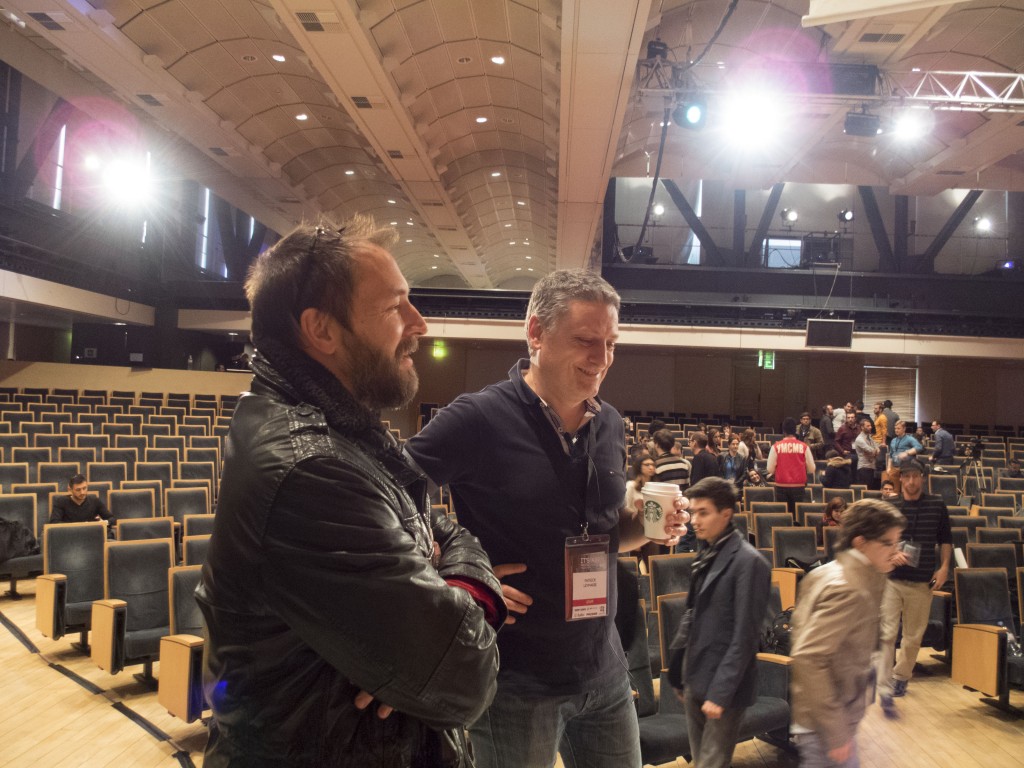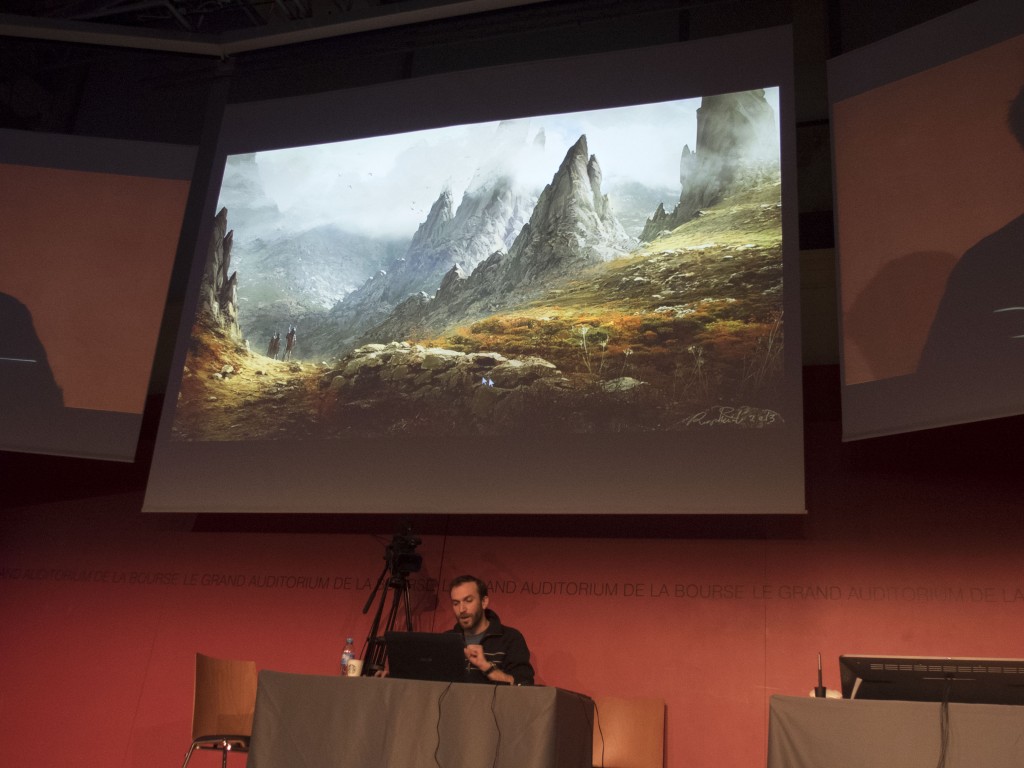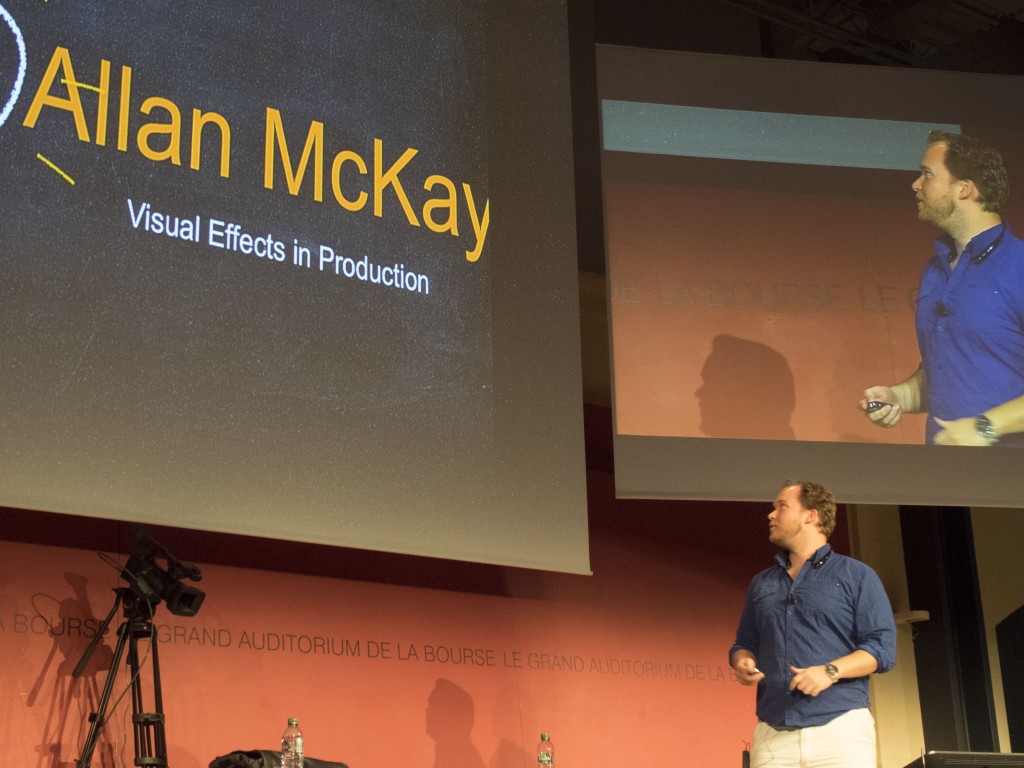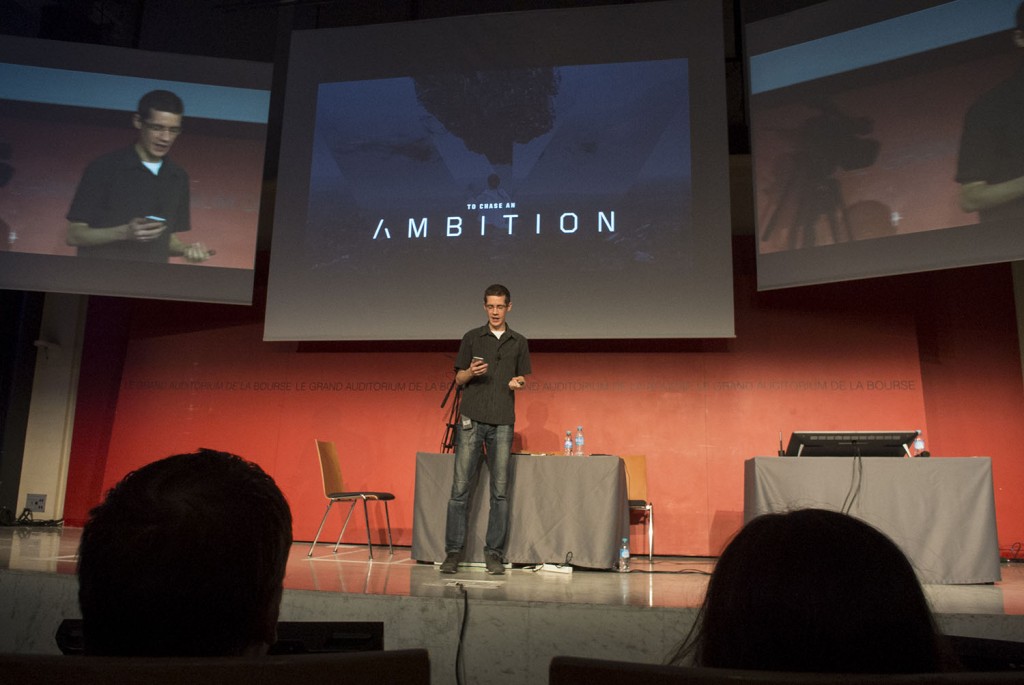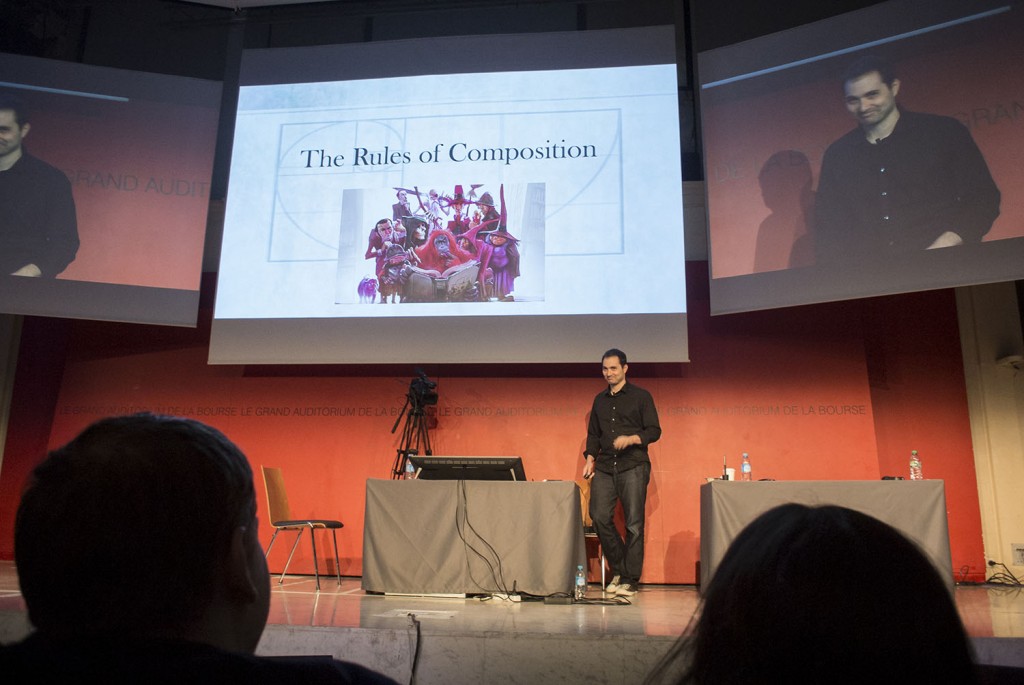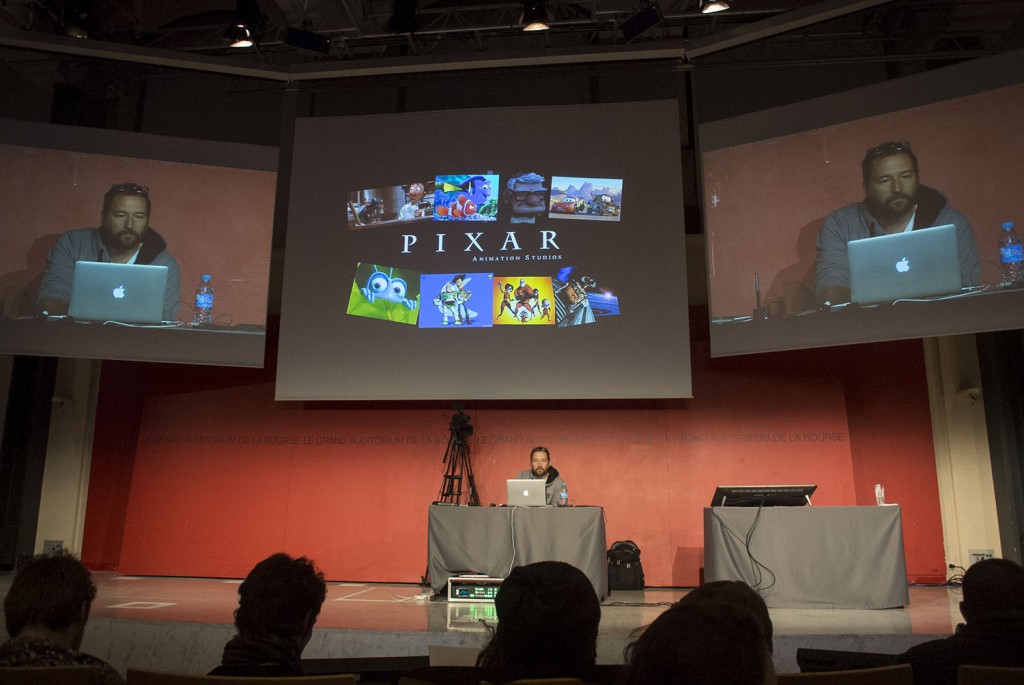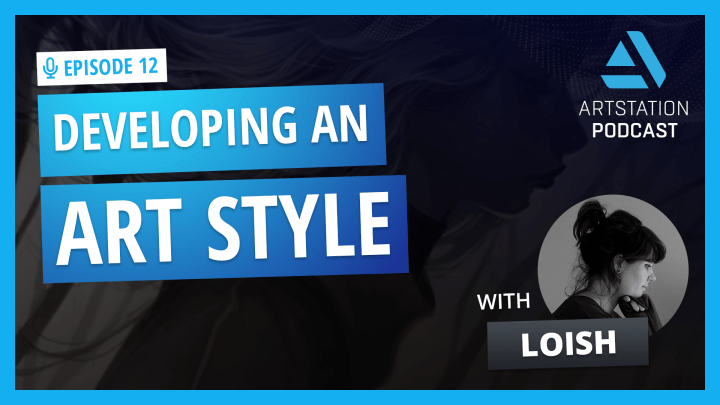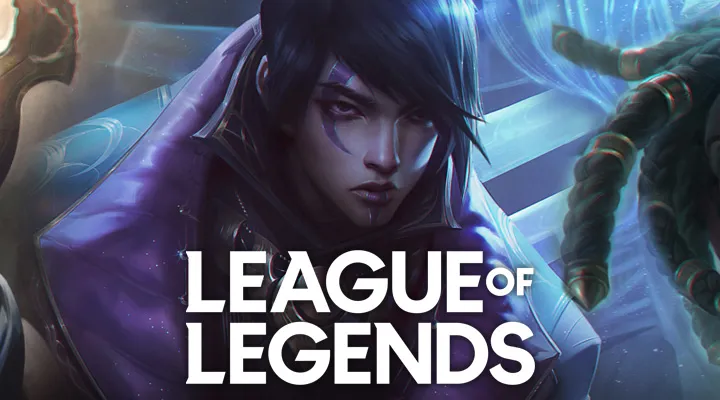It’s Art Master Classes 2015 Round-up
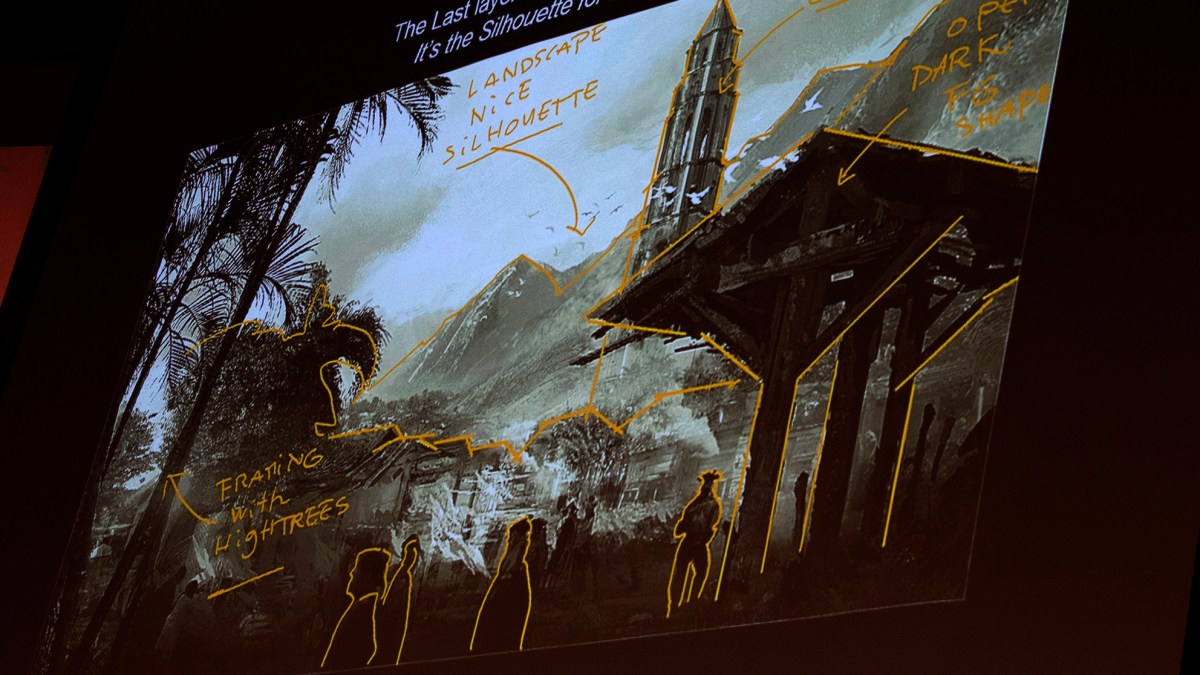
It’s Art held its first Master Classes in Paris in March. Isis Sousa, an IT’S ART Master Classes attendee (and ArtStation member), covered the event.
IT’S ART MASTER CLASSES 2015 – DAY 1
A cloudy and calm Saturday morning in Paris and an event of epic magnitude is about to start. Palais Brongniart opens its gates to receive the creative crowd of students and industry professionals. The expectations are high.
At the lobby Wacom has an exhibition of tablets, other gear and friendly staff at disposition to clear doubts and orient people about the brand’s products. Many gather around to take a look, try and get a feel of the new Wacom Cintiq27QHD, impressive by its size and robust looks.
Opening Ceremony
The auditorium doors are now opened and the crowd takes their seats. The room is huge, has a beautiful illumination and confortable interior. Patrice Leymarie, founder and CEO of IT’S ART gives the attendees a warm welcome and presents Marc Simonetti, the first speaker. The Official Video of the event starts giving us a glimpse of what was about to come.
MARC SIMONETTI – Speedpainting
The French artist asks us if we would like to have a Fantasy/knight painting in daytime, afternoon or night. A night scene it is. As he starts the digital canvas he give us some advices, such as “don’t be afraid of failure” and a confession, “I’m going to fail anyway!”.
He starts the speedy by blocking out some rough shapes with both round and square hard brushes. As he blocks the in grey scale and very subtle chromas, He reveals that he uses custom shape brushes to keep a faster workflow as they are a time saver. He calls it “cheating” and along the process we hear him saying “I cheat a lot – oh yeah!”. Marc shows us how to create a custom brush at Photoshop as well.
As he is close to finish the painting, there are some Questions and Answers with the audience and he talks more about his work process, about layers and flattening of image and so on. Time to move on the next motif, he matches the colors of the painting, finalizing it.
Marc starts the second – faster/simpler – painting, a funny combination of Bob Sponge in a spaceship! Oh wait, you said Bob Sponge in a spaceship?! He starts blocking it in greys and rough shapes, he deforms the main shape of the spaceship to create some perspective. “It is hard, but I try not to use the exact same painting process each time.”
The schedule allows him for a final painting. “Would you like a Zombie illustration? Because this is just how I feel right now!” and he starts blocking it out the on the Cintiq27QHD, using some of the process of the two previous paintings.
He asks for someone of the crowd to stand and serve as reference, which is kind of funny and sketches a zombie-dude with a Wacom pen stuck on the head. He finalizes his humorous ‘masterpiece’ adding a dialogue box to the guy: “BEER”! A huge applause at the end of his charismatic presentation.
ALLAN MCKAY – Deconstructing VFX
Well awaited Allan McKay enters the stage under warm applauses. He introduces himself: “Usually I wanna blow the crap up!”. The audience watches his outstanding and cool video reel containing HUGE amounts of blasts, explosions and destruction! Yay!
During his speech, he talks about the process behind the VFX of films and games he worked such as:
Flight: All sets are digitally built, only a small part of the aircraft is really filmed. The airport is a digital render as they couldn’t film on location. He showed us how elements were added to the plane, airport and plane-crash scene.
God of War Ascension: He talks about the challenges of making the film emotional enough without being cheesy, the technical difficulties of filming the little girl on the turntable. Allan did lots of simulations with a sphere, this way he could get the motion right before worrying about the visual aspect. Then he joins everything into compositing. As for being tight on the deadline, he says: “You wanna cry, but you don’t have time, so you keep working!”.
Transformers: When he started the process, there were too many character renderings to fit in the short deadline. “There was no way I could do it.” He learned then that automating things to pick up the pace. Allan automated the process, delegating the tasks to other artists.
The Equalizer: They used CG blood for everything in a particular violent scene. We watch a massive boat explosion, all details taken to the extreme. “I threw one billion elements there. He tells us initially they looked for something really massive in the VFX, but in the end the direction was to fine tune things a bit down.
In general, Allan looks at reality as inspiration and guidance for his VFX process. He observes and studies elements such as different kinds of explosions – how the smoke, particles and debris behaves on different conditions, study how fire burns and the behavior of the flames, how particular materials break and distribution of masses under laws of physics such as gravity and inertia, etc.
At the end of his engaging speech, he thanks the cheering audience for the patience among the applauses.
RAPHAEL LACOSTE – Composition in Assassin’s Creed
Raphael is very well-received by the audience as one of the most anticipated speakers of the event, due to the huge success of the Assassin’s Creed franchise. And the opening of his speech starts with Black Flag game trailer.
He started out as photographer for a theater company and as such he learned how to frame and the use of lighting as he gathered experience. His career path follows through Dreamworks and Kallisto (extinct).
Later on he got a call from Ubisoft to be art director of Prince of Persia, where some of his main challenges were cultural adaptation and the responsibility to work with an AAA game. In 2007 came Assassin’s Creed, they wanted to move away from fantasy style and go for something more grounded, historical and with grandeur.
“I think art direction for video games should have strong composition, strong moods and atmosphere. It is all very important.”
For Assassin’s Creed Black Flag he states that each moment of the day had to be interesting and memorable. Raphael present us some charts such as different in art direction from Games vs Films and the Keys of Composition. “Composition is key, also lighting.”
He proceeds talking about the organic composition for AC. “Think more systemic, something that looks credible and stylized.”
He talks about the process for creating iconic benchmarks for the islands in the game and how they created immersion and atmosphere to engage the players on the gaming experience. On the creative process he explains about color palettes, proportions, atmosphere and contrasting landscapes.
At the end, we get an insight on the process of his paintings for games and films. Raphael has such artistry on his way to see and capture the world that it reflects back on the beauty of his art direction.
ANDREW SCHMIDT – Giving Life to our character PT I
We watch Andrew’s reel, recognizing many of the films, such as Brave and Toy Story. Also one of the most anticipated speakers, he talks about the beginning of his career and how he started out as part of a B team at Pixar. About Toy Story: “I don’t remember watching it as if it was an animated film. I thought about performance.”
Andrew gives a brilliant and touching lecture, divided by topics such as acting, distinctive characters, performance and how to get your characters to engage the viewers. As he went through these themes, we watched clips and learned quotes that illustrated his point.
Then we come to learning more about motion: “Motion defines character”. He gives us some examples of bad motion (too generic) to intelligent motion (characters/objects with personality). The way a character walks and his mannerisms give a visual of his personality. Dialogues are equality important. We watch some movie clips to understand these points.
On the technical aspect, the “HOW”, we learn Andrew looks for real-life references, ranging from animals, objects and people. It is nice to discover how he films himself mimicking the movements of characters to use the footage as reference in animation! Exploration is an important aspect of the creative process. “Facial expressions are innate to us – we all show fear, anger, surprise, all the same”.
The audience has a good time, with the exciting clips and pics presented as Andrew stresses the importance of expressions and gesturing to make your character a living, breathing creature. He ends this first lecture amidst warm applauses, leaving us with great expectations for the next day. Andrew answers many eager fans and admirers in the auditorium.
LAURENT WITZ – The Making of Mr. Hublot
We watch the full short of Mr. Hublot only to get captivated by its genuine storytelling and intriguing visual aesthetics. No wonder Laurent’s film is an Academy Award Winner. Coincidently it is Laurent’s first film with his own company, Zeilt Productions.
The starting point for the lead character was a sculpture by artist Stephane Halleux. When Laurent saw the sculpture, he got the idea, wrote the script and went after the funding for the project. After some feedback, he tweaked the sculpture for what Mr. Hublot is today.
Laurent’s goes in-depth about the concepts for environments, sets, objects and other aspects of the absurd world of the film. “This was an important moment to think about the artistic direction for the project.” They did color research illustrating each crucial part of the movie to capture the right atmosphere, as well as color-charts to study homogeneity and progression.
“When we decided to make the movie in 3D it was an expensive part.”
It was a huge challenge for the creative direction; they did low-poly buildings with lots of textures. 3D and 2D artists worked together.
“We had a small budget, but I was very confident from the beginning. I told my team that I knew ‘something’ would come out of it – and it did! We won an Oscar!” Laurentz leaves us inspired about the possibility of realizing our dreams, going for something we believe is possible. A cheering applause.
Despite the long day, we leave Palais Brongniart with a burst of inspiration, ideas and excitement. Later on, we crowded a ‘parisiense brasserie’ for drinking, chatting, connecting and enjoying the evening.
IT’S ART MASTER CLASSES 2015 – DAY 2
A calm and cold Sunday morning in Paris, a fit for the melancholic thought that this is the very last day of the Master Classes 2015. The crowd gathers at Palais Brogniart a bit later this time – last night’s party anyone?
RAPHAEL LACOSTE – Career Path
After an excellent an insightful lecture the previous day, Raphael returns to the stage to talk in depth about his career and artistic choices. He applied to games and films the experience he gained at the theater. His work as illustrator inspires his photography, and when he is out there travelling, his shots come to inspire his concepts later on.
We are delighted in seeing some of his photographic explorations on aspects such as framing, lighting and composition. “I love travelling. You get a feeling of the places and things around the world – a good path to use it as inspiration.”
He reveals his passion for old film cameras, and shows some examples on how different film qualities and exposure can give dreamy, atmospheric results on his captures. “The long exposure reveals things that are not visible to the human eye. It is fascinating to discover these things.”
When travelling, Raphael prefers digital cameras as they are very convenient in most situations. He often carries a sketchbook to make take notes and studies.
From beautiful photography to illustration. We watch a presentation of some of his concepts, ranging from complex to simple compositions. He prefers to start his works with a simple composition sketch, then he goes detailing and building mood. He often uses photography to integrate his concepts, mostly textures, as time saver. Raphael also prefers simpler, but more graphic images rather than more detailed renders.
On the use of 3D tools and work, he points out that: “3D is good for interior and buildings, also a good base for perspective.”
He finds 3D too rigid in general and prefers the more painterly approach of 2D media. On films, he reveals that directors prefer very polished images, like if they are the final shot; on his opinion, these kinds of images look very artificial.
Regarding characters, he says: “I’m extremely bad at character design!”. Many times he looks at concepts and thinks they are overly-detailed, lacking good design, pose or silhouette, which are crucial elements to make these creations interesting.
What a great way to start the day, visualizing alluring artworks and learning about what drives Raphael Lacoste as artist and art director.
ALLAN MCKAY – Boost your career in the VFX industry
Allan returns to the stage, this time, not to blow things up, but to teach us how to do “the biggest splash!” (He apologizes for running on empty due to the previous night, which makes us grin!) He tell us that since the beginning of his career he has been looking at reels, giving tips and helping his peers to get their dream jobs – or get out and work on other things.
“A lot of people do tutorials and talk about technical stuff, but not about career, money, business and the like, which is a flaw. Yet these things are extremely important.”
Allan gives us great insights, and here are some highlights:
– Make a 90 second video reel, remember the guys in the industry are very busy. Make it so cool that you leave them wanting more and say ‘I want that guy on my movie!’.
– Make sure you add your location/city on your reel, website and online portfolios. Your next employer can be close and looking to work with people from the same area.
He stresses the importance of a good cover letter. Many artists don’t get their dream jobs because their cover letters were written poorly or were extremely boring to read through. On the screen we see how he builds his cover letter, as he explains each part.
“Every line will get them to read the next. Add all the jobs you can make and most importantly, don’t forget to add what you would like to do.”
He also warns us about a couple of things, to avoid being too technical, because in many cases, most likely a person from the HR (Human Relations) is going to contact you and they may not know anything about the tech stuff. The other thing is to stop the “give me” mentality. Stop asking for things or a job for that matter. Connect, be helpful, understanding and maybe later you may end up getting called for a job.
Allan closes his speech talking about the importance of relationship-building, this is an easy way for people to keep you in mind. And last but not least: “Push yourself, raise the bar, don’t settle.”
PLATIGE – Making of Ambition
Ambition is a short film created in collaboration with the European Space Agency to celebrate their pioneer Rosetta Mission. Its object is to be the first to land on a comet in human history. We watch the beautiful and peculiar trailer. Piotr presents a series of stills, showing the concepts for the film, starting with environments and stones. A particular stone had a quiet philosophical approach, as it was inspired in a blend of dead matter (rock) and human embryo as the film also represented the “birth” of worlds and comets play a big part in it.
They shot it in Iceland, where other films such as Prometheus have been shot in the recent decade. Due to its location, freezing winds and rain were unpredictable, and it helped the mood for the final result. We see a chart comparing the lighting/weather conditions during the shots.
Reality vs. cinematic: Piotr revealed that during some scenes they had to add effects which were not based in reality, to create visual interest in the scenes. It was a challenging process to deliver what was specified by the Agency plus making it work visually. They also took a look at lots of different types of explosions to simulate the crashes and explosions on the film. “I did 90 simulations of the comet explosion!”
In the end he chose one of them and did a compositing with other 5 elements. Due to the passion evolving those working on the short, Ambition was nominated for the VFX Society as one of the top five commercial projects of 2014. “You can always do your best no matter what it is.”
As he is concluding his presentation he also reveals that the project had little finances for what they managed to put together. So they focused on ‘quality, quality, quality’, even though the financial resources were far from ideal. Ambition is a suitable name.
MARC SIMONETTI – Rules of Composition
Always charismatic, Marc comes back to the stage to present Composition as a Visual Language.
“Don’t forget you have to express yourself to make your pic more interesting.”
We see a series of images from different artists, as Marc explains what makes them distinguishable — elements such as color and shape.
For each of the compositional topics, Marc prepared a series of stills to use as examples. These include the following types: Horizontal, Vertical, Diagonal and Curved when it comes to direction. On shapes, he presented Circle, Oval, Rectangle, Triangle and how to create contrast by combining these different shapes.
We went through color charts, as he talked about the psychological mood each color/set of colors can bring to the viewer. He deepened the subject talking about greys, the importance of values (the range between the darkest and lightest chroma/key). On lighting, he stressed that values/lighting change color. For example, an object exposed in the morning sun can look to have different colors by night. It is interesting to see the different examples he chose for lighting a character. “People always look at face and eyes. If you hide the eyes or hands, the character can become mysterious.”
The last part of his speech was about proportions, the famous Rule of Thirds, Divine Proportion, balance, perspective and the complicated Vanishing Points. “3 and 5 vanishing points break the horizontal and vertical lines, making the image more dynamic.” Marc’s class covered many important topics for concept artists and illustrators, in a fun and engaging way.
ANDREW SCHMIDT – Giving Life to your Character PT II
When Andrew enters the stage, the auditorium prepares for a one-of-a-kind class. The day before he talked about HOW to give life to your character, and today, he talks about the WHY.
“At Pixar, acting and performance is most important. Not just movement for the sake of it, but movement with purpose.”
He gives us some examples of bad acting in animation, some clips he got on the web to illustrate the point. These clips fall into this category because the characters are ‘generic’.
“We don’t know what they want, we don’t understand anything.”
We learn that acting is based on conflict and drama, that the character tries different things to reach what he/she desires and a lot of things get in the way. The essence of a character is the result of going through this process. Andrew continue to present us some clips, this time both examples with real actors and animated characters. He often instill questions such as “What does the character want? What do they do to get it? Who stops them? How do they feel?”
He encourages us to think of the character from their point of view and why they do the things they do. We move on to tactics – what do we do to get what we want – and if it doesn’t work, we change strategy. We should also think about status between characters, their position in relation to each other, e.g. teacher-student. We have fun seeing a series of stills to understand this point.
We learn a great deal about facial and corporal expression, posture, posing and mannerisms through the various video clips we see on the screens, which prepare us to the next topic: Acting is reacting. For that, a character needs also stimulus. As important as acting and reacting is also dialogue. We study as well examples of this topic.
“When animating, listen to the dialogue until your head explodes! Find all accents and subtitles in reading the lines. Look for emotional intent.”
Andrew gave us a thrilling class. As we watched the videos, we laughed, feared and felt tense. As he puts it: “Don’t forget that animators are entertainers.”
At the closing ceremony Patrice Leymarie and the speakers come together on the stage, bow and thank the attendees for the great time they had in two remarkable days of learning, teaching and connecting. A standing ovation, cheering and much gratitude echoes in the room and we all leave the building already eager for the next event.
IT’S ART MASTER CLASSES 2016
IT’S ART’s will follow up the success of its inaugural event with an expanded three-day event in 2016 bringing together leading professional artists, students and amateurs to learn, share and network across industries and learn new skillsets. The event is scheduled for 18th-20th March 2016 with limited early-bird tickets available now . If you can’t get in Paris, you can get a video ticket and watch the master classes from any place, one week after the event. All classes are in English.




